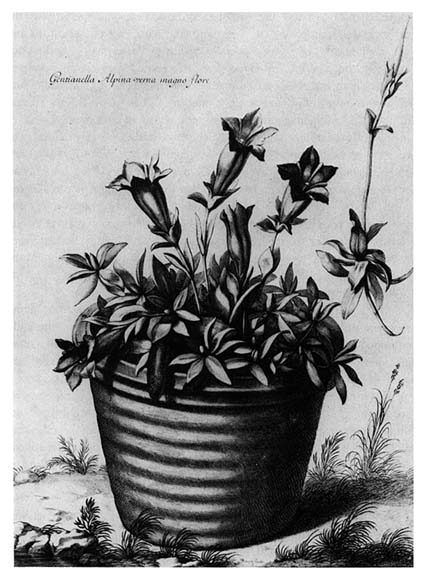Research for the Natural History
Academicians began work soon after Perrault proposed the natural history, but they needed plants for study. Perrault called for an "Academic Garden"[24] and by the 1670s Nicolas Marchant had commandeered part of the vast and unused territory of the Jardin royal for the Academy. This plot became known as the petit jardin and was formally recognized as belonging to the Academy.[25] In it Marchant and his son cultivated seeds from all over the world, collected by friends, acquaintances, and colleagues.[26]
After cultivating a plant, the Marchants described it, gave it to the illustrators, and if there was enough supplied it to Bourdelin for analysis.[27]
Jean Marchant preserved unusual specimens in his cabinet at the Jardin royal.[28] The final description, however, was the collective business of the Academy.[29] While the Marchants read their preliminary drafts aloud at meetings, academicians looked at the plant and proposed improvements; during the spring of 1668 Nicolas Marchant and Duclos debated correct descriptive style.[30] The Academy soon approved a division of labor that persisted for several decades. The Marchants grew plants, not just rare ones, in order to explain their cultivation and development.[31] Bourdelin analyzed plants chemically,[32] while Dodart and the Marchants compiled comprehensive nomenclatures of each plant and wrote descriptions.[33] Finally, the artists drew and engraved the plants, working from life whenever possible. These patterns of work survived changes in the directorship, making the natural history of plants a team project that reflected the ideas and work of several academicians. It was too ambitious an undertaking for any one savant.
Illustrations occupied a prominent place in the natural history and in publicity for the Academy. Engravings of rare plants accompanied Marchant's Descriptions de quelques plantes nouvelles and Dodart's Mémoires des plantes ; they were printed in an expensive folio format that would appeal to the king and encourage him to continue publishing the Academy's work. With the same purpose in mind, academicians showed Louis drawings of plants when he visited the Library in 1681.[34] Illustrations were essential because even the clearest description could not identify a plant so well as a picture of it. John Ray had likened "a history of plants without figures" to "a book of geography without maps," and regretted that engravings were beyond his means; Robert Morison impoverished himself to illustrate his text.[35] Royal funding gave the Academy a distinct advantage over savants who lacked patronage, because the Academy could spend substantial sums on illustrations.
Three engravers — Abraham Bosse, Nicolas Robert, and Louis Claude de Chastillon — shared the work, which cost more than 25,000 livres (table 8)from 1668 through 1699.[36] Like so much of the Academy's program, this too suffered from Louis's wars, and Colbert stopped paying for engravings in 1681, despite the pleas of academicians.[37] Louvois reinstated funding for the Academy's illustrations and Pontchartrain continued it, concentrating his resources on Tournefort's Élémens and finally publishing all of the Academy's engravings of plants in the early eighteenth century.[38] But many of the plants that Bosse, Robert, and Chastillon drew were never engraved.[39]
Academicians tried, not altogether successfully, to hold Bosse, Robert,

Fig. 6.
Gentianella alpina verna magno flore. (From Estampes; engraved
by Bosse; photograph courtesy of Bibliothèque Nationale, Paris.)
and Chastillon to a new standard of scientific accuracy. They supervised the artists closely, comparing drawings and engravings with descriptions and actual plants.[40] They were especially critical of Bosse's work, finding not one of the flowers of Cymbalaria (fig. 3) accurate,[41] protesting the superfluous branch and pot in the picture of Gentianella (fig. 6),[42] and deriding his anthropomorphic Mandragora mas (fig. 7) as "a ridiculous affectation."[43] Chastillon misrepresented the proportions of the leaves to the plant in depicting the mimosa (fig. 1).[44] Microscope and loupe were called for to correct certain features.[45] Extraneous details such as butterflies (fig. 9)[46] and birds marred some illustrations. Chinese characters (fig. 12) betray an engraving taken from an illustration rather than life. Many pictures lacked roots, seeds, and proper scientific names.[47] For reasons of economy, the size of engravings was reduced under Louvois,[48] but for reasons of accuracy, a picture of the seed, flower, and other parts of plants was added to some illustrations (figs. 1, 2).[49] These problems slowed the work, and the engravings as published in 1701 were far from representing the standards of the Academy.
Bourdelin performed the chemical analyses, which the entire Academy reviewed and Dodart interpreted. As soon as the laboratory was minimally equipped in June 1668 Bourdelin began distilling plants,[50] which remained his major occupation until his death in 1699. Indeed, Bourdelin analyzed more plants than were described or illustrated and his reports became a regular fixture at meetings.[51] It took large quantities — a hundred livres according to Dodart's estimate — to analyze a plant thoroughly.[52] Plants that did not grow around Paris.[53] were cultivated in the Jardin royal or were purchased.[54] From Bourdelin's findings Dodart tried to discern the basic composition of plants. Interpretation depended on minutiae, and Dodart struggled unsuccessfully to extract from overly plentiful details the generalizations that would justify Bourdelin's labors.[55]
Academicians collaborated in planning and researching the natural history of plants, and this cooperative spirit was a matter of pride. Four members designed the research, four carried it out, and many others contributed at assemblies. Bourdelin, Nicolas and Jean Marchant, and Dodart were the principal collaborators. Although Perrault proposed the project in 1668, he worked primarily on the natural history of animals, which he had suggested at the same time. But it is odd that Duclos, who directed the project in the 1660s and early 1670s, contributed very little afterwards to its completion. The explanation does not lie wholly in Duclos's preference for other work, such as his study of mineral waters, which distracted him from the natural history of plants.[56] Rather, his
disassociation from the natural history was involuntary, the result of a struggle over who would edit the project.